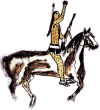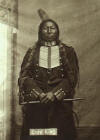


| Company C : Capt. Thomas Custer (brother) |
| Company L: Lt. James Calhoun (brother in-law) |
| Company E: Lt. Algernon Smith |
| Company F: Capt. George Yates |
| Company I: Capt. Miles Keogh |
|
Battle of the Bighorn: June 25, 1876 |
| AIS 100: Introduction to American Indian Studies |
| Palomar College, San Marcos, CA |
The Battle of the Little Bighorn on June 25, 1876 was initiated with the plan of attack order given by George Armstrong Custer to divide his regimental force into three battalions or columns.
The plan of attack sent Capt. Benteen SW as a blocking force, Major Reno to attack the Southern end of the Indian encampment and Colonel Custer attacked the middle of the Indian encampment from the East.
|
|
The Indian Camp was much larger than Custer had envisioned or not paid attention to when warned by his Crow scouts that he had dismissed that morning. The Indian encampment included 12- 15,000 people with as much as 3-5,000 warriors for 3-4 miles along the western bank of the Little Bighorn River.
Two Moons |
N. Cheyenne and Arapaho 500 |
Crazy Horse
 No
picture of Crazy Horse No
picture of Crazy Horse |
Lakota (Oglala, Brule etc), Nakota, and Dakota 2,500 |
Gall
 , Crow King , Crow King , Black Moon , Black Moon |
Lakota (Hunkpapa), Blackfeet Sioux 1,000 |
Major Reno hit the southern part of the Indian encampment around 2:30- 3:00 pm, but never got within a mile and was struck by a force of 1000 warriors under Gall. Subsequently, Reno's men were driven across the river to in a confused retreat to a knoll on the eastside of Little Bighorn River. Benteen later joined Reno's force and helped maintain the command. After receiving a message from Custer's adjunct Cooke to bring ammo packs (delivered by bugler John Martin) and upon hearing gunfire Capt. Weir attempted to move toward Custer's position, but was stopped by an Indian counter attack at what is called Weir Point.
It has never been fully known what Custer's movements were after Martin's message was sent and the exact demise of Custer's five companies. Custer moved north along the eastern bluff of the Little Bighorn River and must have seen the Indian encampment. American Indian accounts indicate that Gall shif6ted approximately 1000 warriors from the knoll Reno was on and struck Lt. Calhoun's Co. L from the southwest. Crazy Horse and Two Moons struck Col . Custer and Capt. T. Custer of Co. C/ Lt. Smith of Co. E from the west and northwest. Capt. Yates of Co. F and Capt. Keogh of Co. I were caught in the middle. It appears that there may have been 2-3 groups of soldiers surround and fighting it out. Col. Custer had had his hair cut and wore his military tunic, not the buckskin depicted in numerous films. Witnesses after the battle state that his wounds were barely visible and that his body was not mutilated. In fact contrary to late accounts very few of the bodies were mutilated, but they were stripped. Capt Keogh was also found surrounded by his men, stripped, but not mutilated. Keogh was also wearing and Agnus Dei (Lamb of God) necklace that was left in place. Capt. Keogh's horse "Comanche" was severely wounded, but was the only survivor after being treated for his wounds. The famous horse was taken to Ft. Meyers and lived for 30 years as regimental mascot. Custer's entire command of 5 companies ~ 210 were killed and Reno/ Benteen lost 53 men. The Indian forces under Crazy Horse, Two Moons and Gall lost ~ 100 warriors killed. Some of these high casualties were due to the fact that some of the Lakota and especially Cheyenne warrior societies took suicide vows based upon Sitting Bull's Sundance vision. Sitting Bull at the time of this battle was a Holy Man (Wicasa Wakan) and did not participate in the battle. Many sources still claim Sitting Bull to the military leader at the Little Bighorn and even the killer of Custer. Both of these assumptions are wrong. Many of the war leaders did not like talking about the battle given the anger of the whites at the loss of their favorite Civil War hero. Furthermore, the news of the defeat reached the East at the time of the July 4, 1876 Centennial Celebration. The Battle of the Little Bighorn quickly became the focus of Custer's heroic martyrdom fueling the wrath of the U.S. Army launching and all out Fall and Winter campaign to round up the Lakota and Cheyenne once and for all. Only Sitting Bull escaped into Canada, only to be given the cold shoulder by other tribes understandably nervous about showing too much friendship to the 'American hostiles'. Crazy Horse eventually came into to Ft. Robinson only to be arrested and stabbed in the back by Indian Police guards in 1877. Crazy Horse's body was quietly taken away and buried in secret.
So the Lakota and their allies had one last victory, but
it only firmed the resolve of European Americans to displace the people of the
Western Plains and continue to destroy their food base, the American Bison. By
1889 there were only 541 Plains Bison left.
Copyright S. J. Crouthamel
Bibliography:
Ambrose, S.E.
1975 Crazy Horse and Custer: The Parallel Lives of Two American Warriors. Doubleday Co.
Andrist, R.K.
1964 The Long Death: The Last Days of the Plains Indian. Macmillan Pub Co. New
York.
Fox, Richard A. Jr.
1997 Archaeology, History, and Custer's Last Battle: The Little Bighorn Reexamined. Oklahoma Press.
Graham, W. A.
1953 The Custer Myth: A Sourcebook of Custeriana. Harrisburg, PA, Stackpole Bks.
Sandoz, Mari
1942 Crazy Horse: The Strange Man of the Oglalas. U. of Neb. Press.